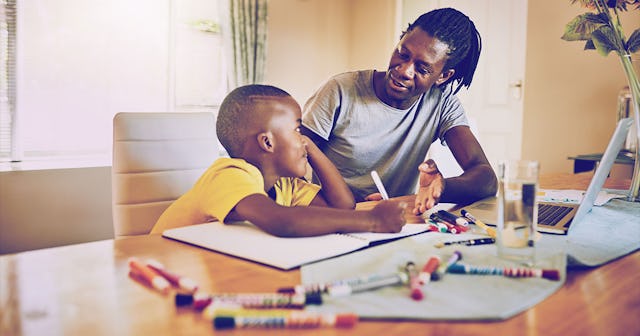Let's Talk About Why Black Families Are Keeping Their Kids Home From School

When the time came for my wife and me to decide whether or not we’d send our kids back to in-person school, it took us about a week to decide. We are a multi-ethnic household; I am Black and my wife is Sri Lankan, and our kids are mixed. My wife, a former 6th grade teacher, and I, someone who’s spent the better part of my career in the nonprofit sector working in the educational sphere, knew we wanted our kids back inside the classroom. If we felt that could safely be done for teachers, staff, and students alike during COVID-19, that was the plan we’d go with. We read and re-read our district’s reopening plan, we talked to our kids, and we prayed about it.
For our family, the right decision was to choose a hybrid model. Our kids are in school two days a week and home three days. While we did not explicitly discuss it in our conversations, my wife and I knew how crucial it was for our kids to take their seats inside of their assigned classrooms. But some Black families across the country chose differently, keeping their kids home full-time as an added safety measure to keep COVID-19 out of their household. When many communities and school districts have chosen to play the game of political roulette (per Trump’s call to have schools reopen), Black communities continue to carry the burdens created by racial inequality.
What we know about this virus is that people with pre-existing conditions are more likely to die from it. And according to the U.S. Department of Health, Black people are 60% more likely to be diagnosed with diabetes and 40% more likely to have hypertension which can lead to heart disease, the number one cause of death among Black people. So, for many families, including my own as my wife has diabetes, sending our kids back to school can be a life and death decision. We know what this virus can do (mostly) and with over 225,000 lives lost in America alone, and 71,000 new cases being reported daily in recent weeks, Black families are scared — and I understand why.
A recent article from Chalkbeat notes, “National and state polls show that Black and Latino parents are more likely to be wary of returning to school in person than white parents. That likely reflects the disparate toll of the pandemic, with people from those communities dying at higher rates from COVID-19.” With some of the hardest-hit communities being communities of color, the decision to keep one’s kids home, while difficult in many ways, was clear. Because choosing to send a kid back to school is risking someone they love — say a grandmother or auntie who has a pre-existing condition.
RichLegg/Getty
When a Black family chooses to keep their kid home for distance learning, to decrease their exposure to this deadly virus, they are making a choice that has not always been granted to them. They are choosing to protect their health in the way they know how, especially when we look at the racial disparities in healthcare.
US News reports, “According to the most recent data available from a federal survey, 13.7% of adults 18 to 64 years old, or 27.2 million people, were uninsured in the first half of 2019 – up from 13.3% in 2018. Racial disparities were apparent: 27.2% of Hispanic adults were uninsured, as were 13.6% of black adults, 7.4% of Asians, and 9.8% of whites. Among adults of multiple races or a race other than Asian, black or white, the uninsured rate was 23%.”
I feel lucky that my family has health insurance and can go into the doctor or emergency room without fear of being able to afford it any time we need to. We know we make up a minority here in the longstanding racial and socio-economic divide which has long plagued America.
Black parents are choosing safety, both for their health and that of their kids, over sending them back into the classroom. But health isn’t the only reason Black parents might feel more comfortable opting for remote learning; in some classrooms, the color of their skin will cause students to be disproportionately singled out, or worse, suspended from school. A 2013 Brown Center Report on American Education looked at one California school district; for every 1,000 Black students, 235 were sent to out-of-school suspension, deepening the educational divide in our country.
The choice of keeping Black kids home is truly a life and death decision on both sides: maintaining safety against COVID-19 and perhaps even keeping their kids on a path to academic safety, not being singled out because of their skin. While we did not choose to keep our kids home, I understand why some Black families saw no other way. The decision is a hard one — to choose health over education as we’ve known it, as we’ve fought to have a seat in the classroom.
At the end of the day, we must do what is right for our family and carefully weigh the options in front of us. As parents, we always have difficult choices to make, which will never end. For families of color, we have struggles others do not face, and we know what they are. We can move ahead as the second wave of the pandemic takes hold of our country, knowing that the power to choose what is best for our own family has never been more important than right now.
This article was originally published on